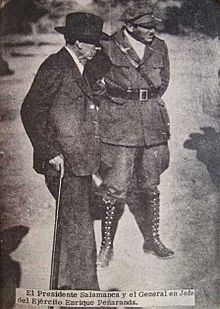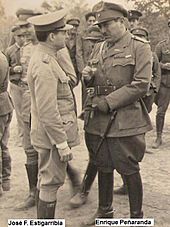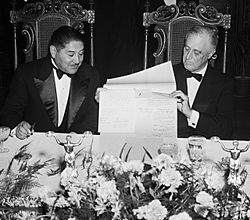Enrique Peñaranda facts for kids
Quick facts for kids
Enrique Peñaranda
|
|
|---|---|
 |
|
| 38th President of Bolivia | |
| In office 15 April 1940 – 20 December 1943 |
|
| Preceded by | Carlos Quintanilla (interim) |
| Succeeded by | Gualberto Villarroel |
| Personal details | |
| Born |
Enrique Peñaranda del Castillo
15 November 1892 Sorata, La Paz, Bolivia |
| Died | 22 December 1969 (aged 77) Madrid, Spain |
| Political party | Concordance |
| Spouse | Graciela Serrano |
| Children | 1 |
| Parents | Teodosio Peñaranda María del Castillo |
| Education | Military College of the Army |
| Signature |  |
| Military service | |
| Allegiance | |
| Branch/service | |
| Years of service | 1910–1935 |
| Rank | General |
| Battles/wars | Chaco War |
| Awards | |
Enrique Peñaranda del Castillo (born 15 November 1892 – died 22 December 1969) was an important Bolivian general. He became the 38th president of Bolivia and served from 1940 until 1943. Before becoming president, he was the main leader of Bolivia's armed forces during the second part of the Chaco War (1932–1935).
After he was elected in 1940, Peñaranda brought back older, more traditional ways of governing Bolivia. These policies had been less popular after the Chaco War. During his time as president, Bolivia joined World War II on the side of the Allied countries. Bolivia promised to help by providing its valuable tin resources for the war. Even though he was popular with other countries, many people in Bolivia were unhappy. In late 1943, he was removed from power in a coup d'état, which is when a government is overthrown by force.
Contents
Early Life and Military Training
Enrique Peñaranda was born on 15 November 1892. His birthplace was a place called Hacienda Porobaya, near what is now Sorata, in the La Paz region of Bolivia. His mother, María del Castillo, was mestizo (mixed heritage). His father, Teodosio Peñaranda, was from the Aymara group, a family that had some political influence.
In 1907, when he was about 15, he joined the Military College of the Army in La Paz. He finished his training in 1910 and became a Second Lieutenant. Peñaranda quickly moved up in the army ranks. He became a lieutenant in 1915 and a captain in 1920. By 1924, he was a major, then a lieutenant colonel in 1928, and finally a colonel in 1932.
The Chaco War
The Chaco War was a big conflict between Bolivia and Paraguay over a disputed area called the Gran Chaco. This war lasted from 1932 to 1935.
Early Battles
In 1932, Colonel Peñaranda was involved in an event that helped start the Chaco War. Bolivia's president, Daniel Salamanca, wanted to settle the land dispute. On 15 July 1932, Peñaranda took part in an attack on a Paraguayan fort called Carlos Antonio López. This fort was located at Pitiantutá Lake.
President Salamanca ordered the Bolivian forces to leave the fort. However, Peñaranda signed a false report saying they were on a different side of the lake. He later said he felt a lot of pressure from his commanders to sign it. This false information caused confusion and made the situation worse.
The Battle of Boquerón
After the incident at Pitiantutá Lake, negotiations between Bolivia and Paraguay failed. Colonel Peñaranda was ordered to take other forts, Corrales and Toledo, which he did in July. On 31 July, Bolivian forces took the Paraguayan fort Boquerón. Paraguay then started a battle in September to get it back.
Peñaranda was told to help the Bolivian soldiers stuck at Boquerón. But his attempts to break through the Paraguayan defenses failed. On 29 September, Paraguayan forces took back Fort Boquerón. After this defeat, Peñaranda became the commander of the 4th Division. He led the Bolivian army's retreat, leaving several forts behind.
Becoming Commander-in-Chief
Bolivia suffered a terrible defeat at the battle of the Campo Vía pocket. Around 9,000 Bolivian soldiers were surrounded and either killed or captured. After this, President Salamanca removed the army's German leader, Hans Kundt. Salamanca then chose Peñaranda to be the new Commander-in-Chief of the Armed Forces. He promoted Peñaranda to brigadier general. Salamanca mistakenly thought Peñaranda had escaped the encirclement, and Peñaranda never corrected him.
However, the relationship between Peñaranda and Salamanca was not good. Salamanca did not trust the military's ability to fight the war. They often disagreed, especially about who should be promoted in the army. Peñaranda believed this was a military decision, while the president thought it was his right to choose.
After another big defeat at the battle of El Carmen in November 1934, Salamanca decided to replace Peñaranda. But before he could, Peñaranda and other officers acted quickly. On 27 November 1934, Major Germán Busch led soldiers to where President Salamanca was staying. They forced Salamanca to resign.
The war finally ended on 12 June 1935, with a peace agreement signed in Buenos Aires. On 18 July 1935, General Enrique Peñaranda met with General José Félix Estigarribia, the commander of the Paraguayan army. This was their first meeting after the war ended.
President of Bolivia (1940–1943)
The 1940 Election
After the Chaco War, Bolivia saw a shift towards more left-leaning ideas. The governments that followed, led by David Toro and Germán Busch, tried out "Military Socialism." This was a mix of military rule and working with labor unions and left-wing groups. When Germán Busch died, more traditional military leaders took over. They made General Carlos Quintanilla the temporary president until new elections could be held.
The older, more traditional parties, like the Liberal and Republican parties, joined together. They formed a group called Concordance. They chose General Enrique Peñaranda as their candidate for president. He was seen as a war hero from the Chaco War. The temporary government also helped Peñaranda by arresting and sending his main opponent, Bernardino Bilbao Rioja, out of the country.
The 1940 Bolivian general election took place on 10 March 1940. With most of the opposition removed, Peñaranda won with a large majority of the votes. He became president on 15 April 1940. However, he did not have a strong majority in Congress, and many people, even in his own group, did not fully trust him.
Joining the Allies in World War II
When Peñaranda became president, his government faced challenges. One big issue was about oil in Bolivia. A previous government had taken over the properties of an American company called Standard Oil. With World War II starting in Europe, the United States wanted to make sure it had access to oil. The U.S. was willing to help Bolivia financially, but they wanted Bolivia to pay back Standard Oil first.
Peñaranda wanted to work with the U.S. but faced opposition from groups like the Revolutionary Nationalist Movement (MNR). These groups strongly supported keeping Bolivia's resources for itself. To get U.S. help without directly dealing with the Standard Oil issue, Peñaranda used an event called the "Nazi Putsch" in July 1941.
Peñaranda declared a state of emergency. This happened after a letter was supposedly found, sent by a Bolivian military officer in Berlin to the German minister in La Paz. The letter suggested a plan to overthrow the Bolivian government. The U.S. minister in La Paz shared this letter. Even though it was later revealed in 1971 that British intelligence had made up the letter to reduce German influence in Bolivia, Peñaranda used it.
He expelled the German minister from the country and arrested several opposition leaders. This event helped convince the U.S. government that Bolivia was against Nazi Germany. Soon after, the U.S. offered Bolivia a large loan. In January 1942, Bolivia and Standard Oil reached an agreement, and Bolivia officially cut ties with the Axis Powers (Germany, Italy, Japan).
After the Attack on Pearl Harbor by Japan, Bolivia showed its support for the U.S. On 7 April 1943, Bolivia officially joined the Allies in World War II. In May 1943, Peñaranda visited several American countries, including the United States. He met with President Franklin Delano Roosevelt. During this visit, Peñaranda promised Bolivia's tin resources to help the Allied war effort. At that time, Bolivia was the only country in the Western Hemisphere that produced and supplied tin. However, Peñaranda's decision to sell the tin at very low prices made many Bolivians unhappy.
Overthrow and Later Life
Even though Peñaranda's government was popular with other countries, people in Bolivia were not happy. Economic problems continued, especially for miners. Workers had gained more rights under previous governments and feared losing them. This unhappiness led to a terrible event known as the Catavi Massacre on 21 December 1942. Many miners were killed while demanding better wages. This event further damaged Peñaranda's reputation.
Less than a year later, on 20 December 1943, President Enrique Peñaranda was removed from power in a coup d'état. This was led by a young military officer named Gualberto Villarroel and supported by the MNR party. After being held for a short time, Peñaranda went into exile and never took part in Bolivian politics again.
He passed away in Madrid, Spain, on 22 December 1969, at the age of 77.
See also
 In Spanish: Enrique Peñaranda para niños
In Spanish: Enrique Peñaranda para niños
- Cabinet of Enrique Peñaranda
- List of presidents of Bolivia





